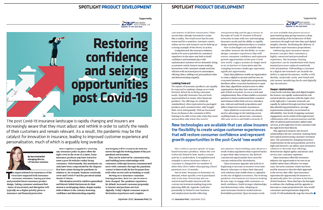London, September 4, 2020
- News & Events
- News

London, September 4, 2020
The unprecedented circumstances of the virus have impacted both insurance consumer sentiment, buying practises and potential future insurance product design. Taking consumer sentiment first - times of uncertainty and disruption will typically see a higher priority given to insurance and financial protection.
More vigilance is applied to ensuring any insurance policy in place offers the right cover in the event of a claim. Some insurance products may have started to seem a poor fit with the reality facing customers. Unfortunately, this sentiment can only have been compounded by the disputes that have arisen during the pandemic in relation to e.g. business continuity cover and Covid-19 and the perceived unfair denial of claims. This situation served to reinforce generalised and historic beliefs that insurers do their utmost to avoid paying claims, despite market wide evidence to the contrary.
Restoring confidence and demonstrating empathy and integrity will be crucial as the industry moves through the evolving phases of the post pandemic environment. This can be achieved by communicating and building better relationships with customers. Although insurers communicated more with customers through the pandemic, contact is historically far less frequent than with other sectors such as banking or retail.

Moving on to insurance consumer buying practises, these too can be seen to have changed. The pandemic experience, by default, increased consumer propensity to interact and purchase services digitally. Today’s digital consumer expects frictionless experiences and complete convenience in all their transactions. Other sectors have already innovated to make this a reality. The retail sector has become renowned for a seamless, customer centric, online service and Amazon can be held up as a strong example of the theory in action. Going forward, the insurance industry needs to be seen to prioritise its customers’ experience in the same way both to instil confidence and maintain pace with sophisticated customer service demands. Being a customer-centric insurer means making interactions with customers simple and time efficient with increased process automation, offering choice, adding real, personalised value and demonstrating empathy.
The nature of insurance products can equally be expected to undergo change as we look forward, driven by evolving consumer needs. Typically insurance has not been as personalised as many other financial products. The offerings are relatively standardised, often represented as packaged products and customers have only bought their cover infrequently.
With an increased focus on finances the consumer will be looking to be able to buy only what they need and possibly only when they need it. This could see greater uptake of usage based insurance [UBI] products, where the cost is directly linked to how much a certain activity is undertaken. A straightforward example is motor insurance where a customer is charged for the number of miles they drive rather than paying a fixed premium over e.g. 12 months. ‘Just in time’ insurance or insurance on demand, where specific cover is purchased only at the time of need may also see renewed and broader interest with the current environment making long term planning difficult. Appetite could also potentially be linked to new business and employment models reflecting entrepreneurship and the GIG economy in the wake of Covid-19. Insurers will need to become in tune with new and emerging insurance needs and the ability to rapidly design and bring related products to market.
New technologies are available that can allow insurers the flexibility to create unique customer experiences that will restore consumer confidence and represent growth opportunities in the post Covid ‘new world’. Legacy systems no longer need to act as barriers to innovation and the changing insurance landscape represents significant opportunity.
Open data platforms enable an organisation to create a digital ecosystem and become an ecosystem business. Application programming interfaces [APIs] allow ecosystem businesses to open their data, algorithms and processes to other organisations that they have selected to be part of their ecosystem. Access to a rich and complementary flow of data enables ecosystem partners to better understand their customer and enhance/tailor their services, introduce new, relevant and timely propositions and deliver improved customer experiences. Open platform ecosystems are already used to advantage in the banking sector, enabling banks to attract new customers, offer new services and build a network of new partners. Open banking came about as a result of data regulations that required banks to open their data resources, the derived commercial opportunities have seen the concept embraced by the industry.
Open insurance appetite and activity is beginning to increase as insurers overcome historic reluctance to share their data and seek solutions that enable them to capitalise on the rise of digital ecosystems. The evolving pandemic environment sees insurers looking for new ways to engage with customers, re-instil confidence, build stronger relationships and demonstrate value. Adopting an open insurance business model unlocks formidable potential. Open insurance tools are now available that pioneer access to open banking data giving insurers a deep understanding of the behaviours of their customers through real-time data and digital insights, thereby facilitating the delivery of innovative open insurance propositions.
Embracing open insurance means insurers can give their customers a highly connected and personalised experience. The insurance buying experience can be transformed with many manual processes replaced seamlessly with automation. Onboarding a customer in a digital environment can include the ability to upload documents, swiftly verify identity, undertake credit, anti-fraud and anti-money laundering checks and digitally sign documents.
Armed with real time data and digital insights the insurer can rapidly understand the risk and provide the customer with the right cover at the right price. Customer renewals can equally be tailored through real time banking data identifying potential new coverage requirements and policy excess based on affordability. New levels of ongoing customer engagement can be achieved through insurer collaboration with ecosystem partners and the offer of tailored and innovative added value services, at the right time for the customer with the right fit for their lifestyle. This approach deepens the insurer relationship with the customer, making them feel valued and boosting customer retention rates. The potential for changing insurance requirements in the post pandemic period is high and insurers can utilise open insurance solutions to diversify their offerings, demonstrate digital agility and attract and service new customer segments.
Open insurance offers the insurance industry the opportunity to be seen as an enabler rather than a blocker. For many years, the term customer centric has been used by insurers to describe their approach to the service they offer. Open insurance represents the opportunity for insurers to dynamically place the customer at the heart of their business. Those that have the foresight to embrace the challenge and the appetite to innovate to create propositions for ‘new world’ consumers and requirements shaped by COVID-19 will undoubtedly reap the rewards.